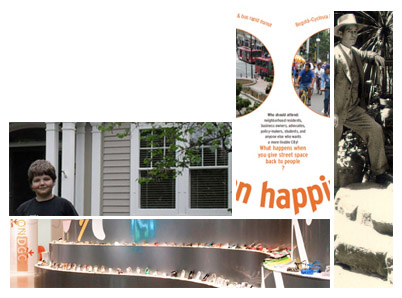CAW offers  Palo Alto architecture history. Gensler on re-imagining department stores. Placemakers on urban happiness. Twelve year-old preservationist. Disaster and Community Capacity.
Palo Alto architecture history. Gensler on re-imagining department stores. Placemakers on urban happiness. Twelve year-old preservationist. Disaster and Community Capacity.
Tribute to an artist and craftsman. Monty Anderson, principal at Cody Anderson Wasney, blogs about Pedro de Lemos, a self taught architect, craftsman and artist.
Anderson compares de Lemos with architect Birge Clark, and discusses his first de Lemos’ project, which was his home in Palo Alto and all the significant architectural contributions de Lemos made in the Palo Alto community.
Resurgence of the department store. Kathleen Jordan, a principal in Gensler’s New York office, blogs about the future of the department store as there has been talk for years how department stores are dying.
“Department stores currently sit on a precipice: sales are languishing, malls are struggling, and their future existence is in question. But it doesn’t have to be this way. Exciting new strategies are emerging that capitalize on changing shopping habits and advances in technology. Department stores are uniquely positioned to lead this paradigm shift in the retail experience that consumers are already demanding.” – Kathleen Jordan
Urban happiness. Hazel Borys, principal at Placemakers, writes on how we measure happiness, exploring if national happiness, well-being, and social capital are related to the way we plan our neighborhoods, towns and cities.
Borys explores how city of Vancouver is asking itself what more it can do to provide for physical, social, emotional, and spiritual needs. Borys says, “The city has added spirit to the other pillars of a healthy community: complete community (land use, density); healthy mobility (transit); healthy buildings (zero carbon); thriving landscapes (open space); green infrastructure (water, sewers, storm); healthy food systems (organic agriculture, nutrition); healthy community (facilities, programs); and healthy abundance (sustainable economic development).”
Via Placeshakers and Newsmakers
Young preservationist. Laura Wainmain, of the National Trust for Historic Preservation, talks to Daniel Linley on how young preservationists are saving places around the country.
Twelve-year-old Daniel of Elkhart, Indiana, set out to compare the energy efficiency of windows in his home ranging from 1920 to 2002. Daniel and this father tested each window three times after a period of 30 minutes, and performed all their tests at night so that the sun would not corrupt their data. Daniel discovered the living room windows from 1920 emerged the winners after holding in nearly 70% of the heat, while a single-paned window held in nothing.
Via National Trust for Historic Preservation Blog
Disasters and community capacity. Project for Public Spaces and Peter Smith, CEO of the Adelaide City Council in Australia, have been working together to create new models of governance and organizational culture that are more supportive of placemaking.
Here’s an excerpt from the paper that shows how this model of governance needs be nurtured to attain true resilience in time of crisis:
It can be argued that community resilience is not just about returning to the previous state of “community capacity,” but about building community competencies so that community capacity continues to increase over time and supersedes the previous state. In this context, community capacity can be thought of in terms of community attributes, such as the ability to self-manage and self-determine, the level of entrepreneurship, concern about issues/activism, volunteering and the general level of positivity/optimism about the future.
Via Project for Public Space’s Placemaking Blog
